- Kitchens
- Design Ideas
- Cities
- Trends
- Guides
- Price Calculators
- Our PortfolioNEW
- More
Tulsi Plant: Sow, Grow, Vastu & More
Sitting in the home’s centre or garden with a special pedestal-like seat, we all have seen Holy Tulsi. Every home in India grows this plant and prunes the leaves now and then for their evening tea. But do you know why? Well, if you don’t, then today is your lucky day!
Table of Content
Difference Between Basil & Holy Basil
History of Holi Tulsi
Types of Holy Basil
Benefits of Tulsi Plant
How and when do you harvest your tulsi plant seeds?
How to Sow The Tulsi Seeds
How to Take Care of the Tulsi Plant?
How do you Know if Your Tulsi is Healthy?
What to Do if it's not?
Lesser Know Facts About Tulsi
Conclusion
Sitting in the home’s centre or garden with a special pedestal-like seat, we all have seen Holy Tulsi. Every home in India grows this plant and prunes the leaves now and then for their evening tea. But do you know why? Well, if you don’t, then today is your lucky day!
This article is about holy Tulsi'history, growth techniques, and everything about the plant. But before you dip your toes in the heavy stuff, let’s start with the basics. The first section will tell you how the holy basil differs from the one you put on a pizza.
Difference Between Basil & Holy Basil
Here is a table describing the differences between tulsi and the basil used in Italian dishes.
|
Category |
Basil |
Holy Basil |
|
Scientific Name |
Ocimum basilicum |
Ocimum tenuiflorum or Ocimum sanctum |
|
Flavour |
Sweet, slightly peppery |
Pungent, peppery, with a hint of clove |
|
Aroma |
Fresh and sweet |
Strong and spicy |
|
Culinary Use |
Commonly used in Mediterranean and Western cuisines |
Commonly used in Indian, Thai, and Southeast Asian cuisines |
|
Growing Conditions |
Adaptable to various conditions, often grown as an annual herb |
Native to Southeast Asia, it requires warm and tropical conditions and is often grown as a perennial |
|
Leaves |
Smooth, green |
More jagged or toothed edges can range from green to purple |
History of Holi Tulsi
Tulsi has a long and special history in India. People have respected it for ages. As per the Vedas, Tulsi is seen as a symbolic representation of Goddess Lakshmi after the big event in the sky called the cosmic ocean churning.
Long ago, a precious pot of nectar came up in the middle of this commotion. The gods wanted the nectar, but so did the demons, especially a powerful demon named Jalandhar. His wife, Vrinda, was loyal and pure to him and decided to go for the nectar.
To stop the demon, the gods decided to trick Jalandhar. So, they made a plan! Lord Vishnu took charge in the form of Jalandhar and tricked Vrinda. The lords kill Jalandhar, and since Vrinda’s love is true, she knows something is wrong. She discovered what happened, which made her sad and angry. She cursed Lord Vishnu out of wrath and turned him into a stone. She later turned into the Tulsi plant. In the end, Lord Vishnu saw her devotion and blessed her to be sacred in Tulsi. That’s why we keep tulsi in our homes.
Types of Holy Basil
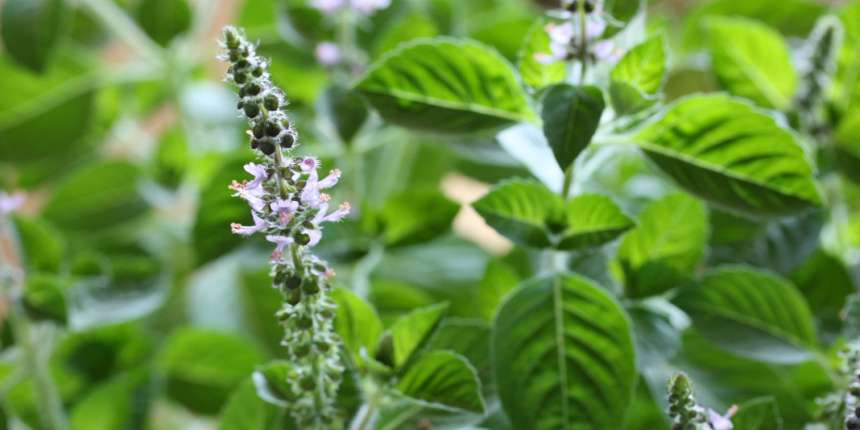 Each holy basil type has its attributes. People cultivate and use these varieties based on their distinct qualities in traditional medicine and daily life. Here is the list of species of holy basil
Each holy basil type has its attributes. People cultivate and use these varieties based on their distinct qualities in traditional medicine and daily life. Here is the list of species of holy basil
Rama Tulsi (Bright Tulsi)
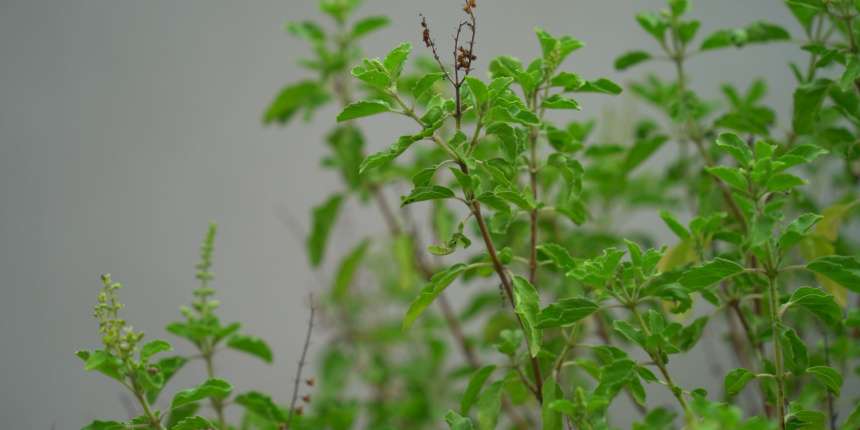
Rama Tulsi or Bright Tulsi is characterised by its larger leaves. It is commonly found in India, China, Nepal, and South America. People value Rama Tulsi for its contribution to good digestion. It has a softer taste compared to other holy basils, but when its leaves are crushed, it releases a stronger aroma.
Krishna Tulsi (Purple-Leaf Basil)
 Krishna Tulsi, or Purple-Leaf Basil, is less common than its green one. It is particularly effective in treating skin, ear, and respiratory infections. Known for its spicy and savoury taste, Krishna Tulsi matures more slowly than other types. It has a milder flavour and is less astringent.
Krishna Tulsi, or Purple-Leaf Basil, is less common than its green one. It is particularly effective in treating skin, ear, and respiratory infections. Known for its spicy and savoury taste, Krishna Tulsi matures more slowly than other types. It has a milder flavour and is less astringent.
Vana Tulsi
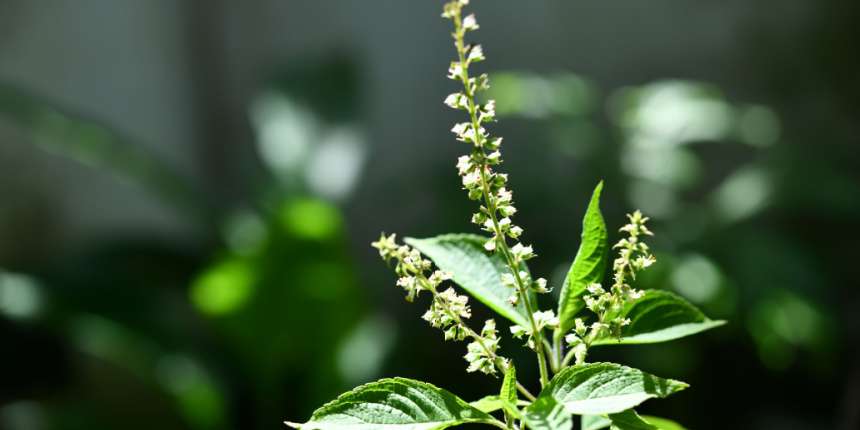 Vana Tulsi is the rarest type of holy basil and grows only in the wild of the Himalayas. It is considered one of the most delicious and healthful forms of holy basil. The top leaves of Vana Tulsi are pale green, while the lower ones are darker. It stands out for its unique characteristics and benefits.
Vana Tulsi is the rarest type of holy basil and grows only in the wild of the Himalayas. It is considered one of the most delicious and healthful forms of holy basil. The top leaves of Vana Tulsi are pale green, while the lower ones are darker. It stands out for its unique characteristics and benefits.
Benefits of Tulsi Plant
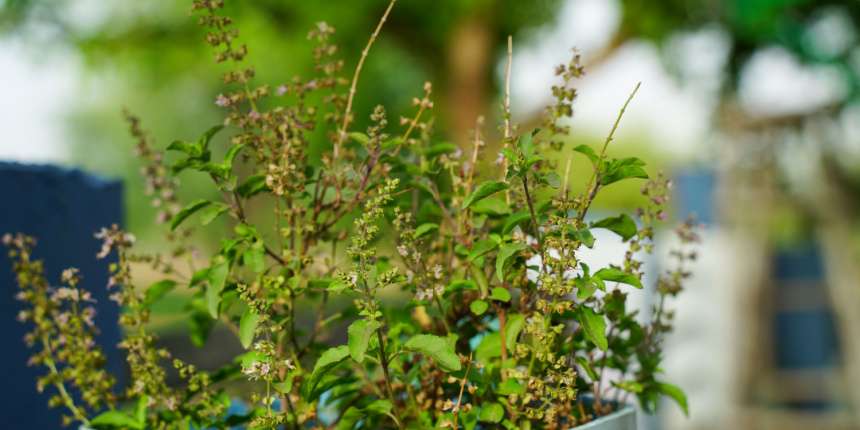 Types of Tulsi go beyond being just plants. So, whether you need a happy stomach or a wild twist, there’s a Tulsi. Here are your benefits separated based on their types.
Types of Tulsi go beyond being just plants. So, whether you need a happy stomach or a wild twist, there’s a Tulsi. Here are your benefits separated based on their types.
Rama Tulsi (Ocimum Tenuiflorum)
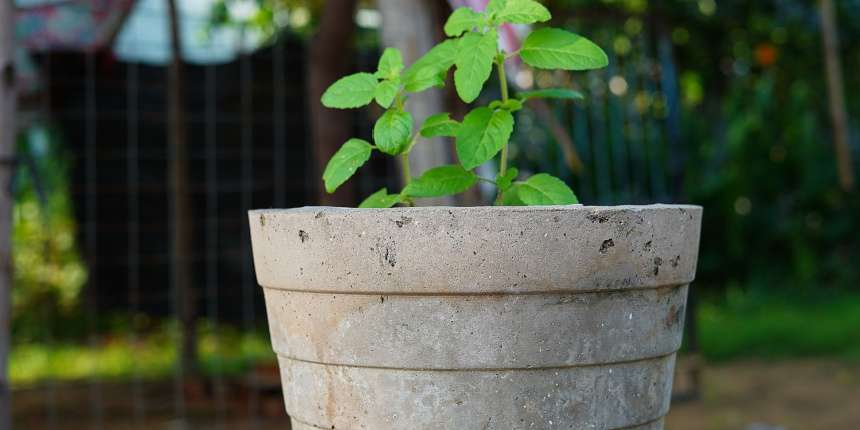 Rama Tulsi takes the forefront in promoting digestive wellness, offering relief from common digestive issues. Its mild taste makes it versatile for culinary applications. When crushed, the aromatic essence enhances both culinary and sensory experiences.
Rama Tulsi takes the forefront in promoting digestive wellness, offering relief from common digestive issues. Its mild taste makes it versatile for culinary applications. When crushed, the aromatic essence enhances both culinary and sensory experiences.
Krishna Tulsi (Ocimum Tenuiflorum – Purple Leaf)
 Krishna Tulsi is effective in treating skin, ear, and respiratory infections. Beyond its medicinal properties, its spicy and pungent taste adds a unique flavour to culinary dishes. The slow maturation process contributes to its robust flavour.
Krishna Tulsi is effective in treating skin, ear, and respiratory infections. Beyond its medicinal properties, its spicy and pungent taste adds a unique flavour to culinary dishes. The slow maturation process contributes to its robust flavour.
Vana Tulsi (Ocimum Gratissimum)
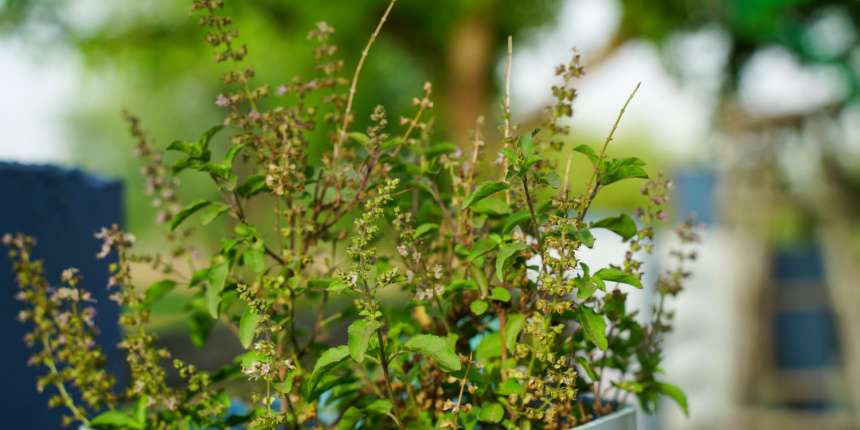 Vana Tulsi is celebrated for its delicious and healthful attributes. Its pale green top leaves and darker green lower leaves create a visually striking contrast. Clutching its wild growth, Vana Tulsi adds a touch of diversity to the whole family of holy basil.
Vana Tulsi is celebrated for its delicious and healthful attributes. Its pale green top leaves and darker green lower leaves create a visually striking contrast. Clutching its wild growth, Vana Tulsi adds a touch of diversity to the whole family of holy basil.
How and when do you harvest your tulsi plant seeds?
 When you want Tulsi seeds, look at the plant as it grows. Wait until the flowers dry and small seed pods appear. When these pods turn brown and open, it’s time to harvest. The seeds inside are usually black or brown.
When you want Tulsi seeds, look at the plant as it grows. Wait until the flowers dry and small seed pods appear. When these pods turn brown and open, it’s time to harvest. The seeds inside are usually black or brown.
Use scissors to cut the whole branch with the seeds. Let the branches dry in a breezy place. After drying, crush the seed pods to get the seeds. Separate the seeds from the plant bits. Keep the seeds in a cool, dry spot in a closed container or small bags.
How to Sow The Tulsi Seeds
Prepare well-draining soil with a pH between 6.0 and 7.5 to sow Tulsi plant seeds. The optimal sowing time is at the end of spring or the beginning of summer, with temperatures around 60-70°F (15-21°C). Scatter the Tulsi seeds on the surface, gently pressing them down for good soil contact. Place the planted seeds in a warm, brightly shaded area with partial morning sunlight. Keep the soil constantly damp, as germination takes about one to two weeks. Once the seedlings have two or three sets of true leaves, carefully transplant them into separate pots or outdoors.
How to Take Care of the Tulsi Plant?
 To care for a Tulsi plant, provide well-draining, nutrient-rich soil with a pH between 6.0 and 7.5. Ensure it receives at least 4 hours of sunlight daily. In colder months, bring it indoors to a sunny spot above 50°F (10°C).
To care for a Tulsi plant, provide well-draining, nutrient-rich soil with a pH between 6.0 and 7.5. Ensure it receives at least 4 hours of sunlight daily. In colder months, bring it indoors to a sunny spot above 50°F (10°C).
Water when the top inch of soil is dry, keeping it slightly damp in summer. Reduce water during winter.
Pinch the tips after four to six pairs of leaves to encourage bushier growth. Prune off flower buds to promote a fuller shape. Regularly prune dead leaves and flowers for a healthy plant.
Fertilise every four weeks during the growing season and add compost yearly. Watch for pests like aphids and use insecticidal soap if needed.
How do you Know if Your Tulsi is Healthy?
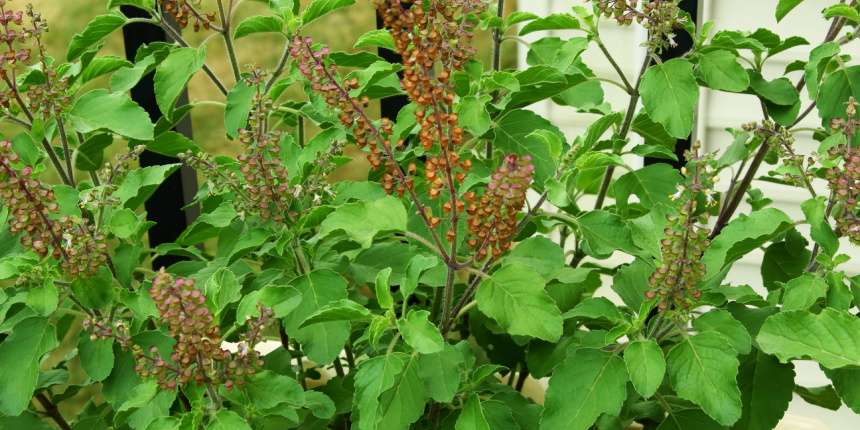 A healthy Tulsi plant has vibrant green leaves without yellowing or wilting. The plant should be bushy and full, not sparse. Check the soil ' it should be slightly damp, not too wet or dry. Also, watch out for any tiny bugs on the leaves. Here are some ways to know about the pest.
A healthy Tulsi plant has vibrant green leaves without yellowing or wilting. The plant should be bushy and full, not sparse. Check the soil ' it should be slightly damp, not too wet or dry. Also, watch out for any tiny bugs on the leaves. Here are some ways to know about the pest.
- Aphids can be green or black.
- Mealy bugs look like small cottony spots.
- Spider mites create tiny webs.
- Whiteflies are tiny and white.
What to Do if it’s not?
 Each Tulsi plant is unique, and adjusting your care routine based on its responses will forge a strong bond between you and this sacred herb. Here are some valuable insights to guide you:
Each Tulsi plant is unique, and adjusting your care routine based on its responses will forge a strong bond between you and this sacred herb. Here are some valuable insights to guide you:
- Observation is key. Yellowing leaves, wilting, or unusual spots could signal an underlying issue. Regularly inspect your Tulsi plant to catch early signs of distress.
- For Aphids: Spray them off with a strong stream of water. Use insecticidal soap or introduce natural predators like ladybugs.
- For Mealy Bugs: Wipe them off with a cotton swab dipped in rubbing alcohol. Use neem oil or insecticidal soap. Prune and dispose of heavily infested parts.
- For Spider Mites: Spray leaves with water to reduce dust. Use insecticidal soap or neem oil. Increase humidity around the plant.
- Whiteflies: Spray with neem oil or insecticidal soap. Introduce natural predators like parasitic wasps. Use yellow sticky traps to catch adult whiteflies.
Watering:
Strike the right balance. Tulsi prefers slightly damp soil, so water when the top inch feels dry. Avoid extremes ' overwatering can lead to root rot, while underwatering can cause stress.
Sunlight:
Tulsi thrives in sunlight. Ensure it gets at least 4 hours of sunlight daily. If your plant appears leggy or stretched, it might crave more sunshine.
Soil Quality:
Well-draining soil is a Tulsi favourite. Check soil quality for good drainage. If the soil feels too compacted, consider repotting with well-draining soil.
Pest:
Watch for unwanted guests like aphids, mealy bugs, spider mites, or whiteflies. Combat them with natural solutions like insecticidal soap or neem oil.
Pruning:
Trimming yellow or diseased leaves is akin to a spa day for your Tulsi. Regular pruning encourages healthier growth and better utilisation of energy.
Fertilisers:
During the growing season, offer a balanced liquid fertiliser every four weeks. As winter approaches, scale back on fertilisation to support a more dormant phase.
Protecting from the Chill:
Tulsi is no fan of the cold. Shield it from frosty temperatures by bringing it indoors to a cosy spot above 50 degrees Fahrenheit.
Lesser Know Facts About Tulsi

- Highlighted in Ayurvedic scriptures like Charaka Samhita, tulsi holds a dual role in religious rituals and holistic health.
- Tulsi is a natural pest deterrent, emitting compounds that repel insects, contributing to a bug-free environment.
- Tulsi not only supports respiratory health but also aids in managing respiratory disorders through steam inhalation.
- Classified as an adaptogen, Tulsi helps the body adapt to stress, providing a natural coping mechanism.
- Surrounded by folklore, Tulsi is symbolically linked to the goddess Lakshmi, who represents prosperity and calm in Hindu households.
- Ayurveda attributes spiritual significance to Tulsi, considering it a tonic for the mind and soul.
- Placing Tulsi leaves in water is believed to purify both physical impurities and negative energy.
Conclusion
Here is everything on Tulsi plants! From telling the differences to actually knowing the depth of its holiness, we’ve got the lowdown on their benefits. We’ll also have added ropes on harvesting, planting, and loving your tulsi plant. Plus, we’ve got some juicy deets on Tulsi’s Ayurvedic perks and spiritual vibes. Get ready to level up your Tulsi game and make your home a chill haven for this sacred herb! Stay with us to learn about Vasu, gardening, and other home- and interior-oriented stuff!
Ready for a home transformation?
Let our designers assist you!
Recent Posts
It’s not exactly summer, but you can keep the Tulsi indoors for winter. Just pop it near a sunny window, and you’re ready.
Nope! Rama Tulsi is the mild one, while Krishna Tulsi brings the spice. Vana Tulsi? Well, it’s the wild child, offering a unique flavour party.
You can, but it might be intense. The flavours are potent, especially in Krishna Tulsi. Toss them in your favourite dish for a flavour boost!
Watch for signs like droopy leaves, weird spots, or a lack of enthusiasm. Think of it as your plant-dropping hints.
Yup, you can give it a shot! Grab seeds from your local store, plant them with love, and watch your Tulsi family grow.
Related Category
- Balcony
- Exterior Design
- Lighting
- Materials
- Tips and Advice



































